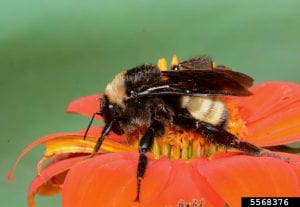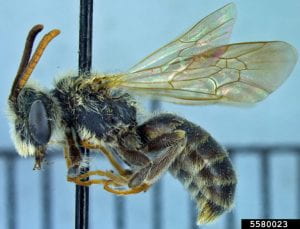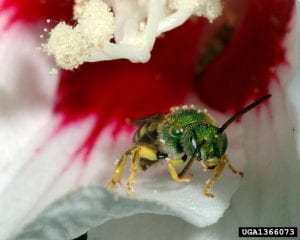Which Native Bee Is That?
By Susan I., Sparrowbush Senior Master Gardener
This article appeared in the June 2019 Issue of Gardening in Orange County. Click here to subscribe!
Even though there are almost 400 species of native bees in New York, these bees usually zoom right under our radar. They work and nest on our property yet are often unrecognized and unnoticed (let alone understood) as the crucial pollinators of our flowers and food crops. Most natives are not aggressive and sting only if provoked. Unfortunately, they often get mistaken for bellicose wasps or hornets and, sadly, are obliterated.
Bees evolved from insect-devouring wasps 100 million years ago. Bees are wasps that went vegetarian. They evolved away from hunting insects to bee species adapted for efficiently gathering more nutritious pollen to feed their larvae.
Three-fourths of our native Orange County bees are ground-nesters that dig tunnels or take over beetle or mouse burrows. The rest nest above ground in straw-like stems, twigs, stonewalls, or in hollowed-out deadwood. Most of them are solitary – meaning the queens build, gather, provision, and care for their nests all alone. Males often look like a smaller version of their queens.

Bumblebees – Bombus
Closely related to foreign honeybees, these charismatic bees have an iconic stocky, round shape and small wings that defy the aerodynamics of lift and drag. The distinctive flat shiny spot on female’s back legs is surrounded by hairs to form a pollen basket. They use this basket to transport pollen wetted with nectar, but, unlike the honeybee, they never stockpile it. Bumblebees live in ground dwellings, not hives, and are distinguishable by their waist-less anatomy covered in black and yellow hair, especially on the abdomen. Queens make their nests in animal tunnels or tussock grasses. A queen will travel up to a mile for pollen to feed her young, usually referred to as her brood. The more flowers available for pollen, the larger her brood. Colonies last only one season – compelling swift, and prodigious pollen collection, 15 times that of the honey bee. Males leave the nest and do not normally return, spending their time feeding on nectar and trying to mate.
Bumblebees are flower generalists and are the preeminent pollinators of tomatoes. To do this, they clutch the tomato flower and vibrate their abdomen to shake out the pollen found inside.

Mining Bees
These strong bees dig deep ground-nests leaving volcano-shaped mounds in sand, clay, grass or under fallen leaves. Often their nests are aggregated and are easily spotted when females are orientating themselves to the “door” of their nest by flying in larger and larger figure eights around it. Males can also be seen swarming around the complex, but instead of orientating themselves, they are looking for an opportunity to mate. Although one hole leads to many underground “apartments”, each queen lives separately with her brood. The communities’ females exhibit an orderly morning exodus one at a time.
Our most numerous native bees, miner bees fly only from late April to July. They emerge to the surface at around 40 – 50 °F to absorb the sun’s warming rays, and take of flying when temperatures reach 50 – 60 °F. They fly fast and are valued for pollinating early morning flowers that bloom before honey bees wake up.

Carpenter Bees – Xylocopa virginica
Common in Orange County, carpenter bees are the largest of our native bees. Females resemble bumblebees – only they are larger and have a hairless shiny black abdomen. Males’ faces are yellow while females’ faces are black. They are named “carpenter bees” because they cut precise round galleries for nests inside sound, undecayed soft wood. They avoid wood covered with paint or bark and have been known to cut their galleries in fence posts, wooden benches and houses leaving what some would consider unsightly holes and stains. Males are attracted to sudden movements and conspicuously hover closely to people or in front of nests. They also engage in aggressive territorial battles for mating opportunities, but fortunately for us males cannot sting. Females can sting, but only do so when molested. Adults emerge during the summer and fall and can live for up to three years. Females will sometimes cohabitate with their daughters and, unlike most native bees, carpenter bees will reuse old nests. Carpenter bees are beneficial and important pollinators, especially of open-faced flowers.
New York’s several species of Mason bees choose above ground nesting sites in preexisting cavities such as twigs, hollow stems, and beetle burrows. Child and pet-friendly Mason bees are far too busy to be aggressive. They only sting as a last resort, and the venom they release is very mild. If you’re allergic to honeybees, this solitary, docile pollinating rock star is easy to keep and a great alternative. They cross-pollinate a wide variety of trees and plants instead of focusing on stripping pollen and nectar from one location. You can help protect them in winter by leaving standing hollow-stemmed plants.

Leaf Cutter Bees
The female leaf cutter bee makes small circular cuts in living or dried leaves or petals. She curls them up to carry back and line her nest. Attracting these gentle yet vigorous pollinators requires growing plants with thin-walled leaves, such as roses, hostas, peas, and lilacs. Because they build their nests near one another and are 15 times more valuable as pollinators than honey bees, they aid farms and gardens where lots of bees are needed. Unlike carpenter bees, solitary leaf cutter bees cause no damage to structures, because they lay their eggs in existing holes.
They are more round, cigar- or submarine-shaped than other bees and carry collected pollen on their abdomen. Distinguishable from honeybees, they have no brown/yellow stripes on their abdomen.

Sweat Bees
Sweat bees make up for their minute size with their incredible numbers and are among the most abundant and commonly seen bees in North America. They are attracted to the proteins, moisture and salt on sweaty arms, legs, and necks. Don’t swat! Females will sting if brushed against or agitated, and they will release pheromones attracting more bees.
Up to twenty-four solitary females dig deep burrows in banks or on flat or sloping soil – they then share the entrance into the nest. They are most active in late spring and summer. Sweat bees have short tongues which makes it difficult for them to extract nectar from deep flowers. For this reason, they are attracted to open-face flowers.
FYI – Wasps

Although wasps are usually considered pests, adult wasps are considered beneficial since they capture insects for their developing larvae. They also feed on sweet nectar (and can annoy picnics in late summer by scavenging on human food).

Some of the more common wasps found in our area are yellow jackets, bald-faced hornets, and paper wasps. Yellow jackets usually build their nests in the ground or in voids found in buildings. Their colonies last only one season and nests are not reused. Bald-faced hornets are actually not true wasps, but a type of yellow jacket. They are large black and white wasps that make the grayish papery, pear-shaped hives (mistakenly illustrated as Winnie the Pooh’s “honey bee hive”) found hanging from trees or shrubs. Bald-face hornets also do not reuse their nests. Like the bald-faced hornets, paper wasps also make papery nests, but their nests have open combs.

Just remember that wasps are considered beneficial, so unless their nests are in an undesirable place, they should be left alone. One way to dissuade wasps from nesting near your home is to use an imitation wasp nest. (These can be crocheted or purchased.) As visual creatures, when they see another “wasp” nest in the area they assume it’s another competitor and do not build there.
It’s clear that bees are good for our gardens and as long as our gardens provide reliable pollen and nectar sources, our gardens are good for the bees. Unfortunately our native bees are in decline due to loss of habitat, residual pesticides in their food sources, pathogens, mites and diseases. Our first step in helping them is understanding them and their ways. Protect their livelihood by proliferating their only food source – flowers – which renew and sustain them year-after year. Here are a few other things that you can do to help protect the bees:
- plant flowers in swaths
- remember that although modified, doubled-petaled cultivars are ascetically pleasing to the eye, they have less nectar than native cultivars of the same flower
- choose diverse flowers, preferably natives species
- intersperse decorative flowers among vegetables
- allow some of your herbs bolt, producing flowers
- minimize your use of neonicotinoid pesticides which move systemically through the plant into plant pollen and nectar and can weaken bees’ immune systems.
Flower Power!
More flowers = Higher bee numbers!
In the bargain, humans get free pollinating labor assuring healthy vegetation and reliable fresh foods – and we get to revel in Nature’s door-prize of life – the magnificent, ravishing, inestimable flower.

For more information about Wild Bees of New York visit Cornell’s Pollinator Website (https://pollinator.cals.cornell.edu/wild-bees-new-york/).

![stanze from Germany, Baden-Württemberg [CC BY-SA 2.0 (https://creativecommons.org/licenses/by-sa/2.0)] Mason bee on board with](https://blogs.cornell.edu/master-gardeners-cce-oc/files/2019/04/Mason_bee_apartment_building-ugwjwf-300x275.jpg)